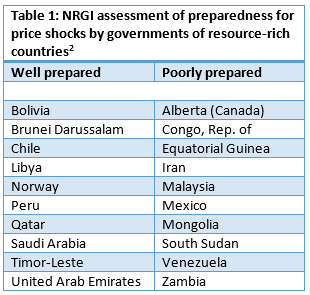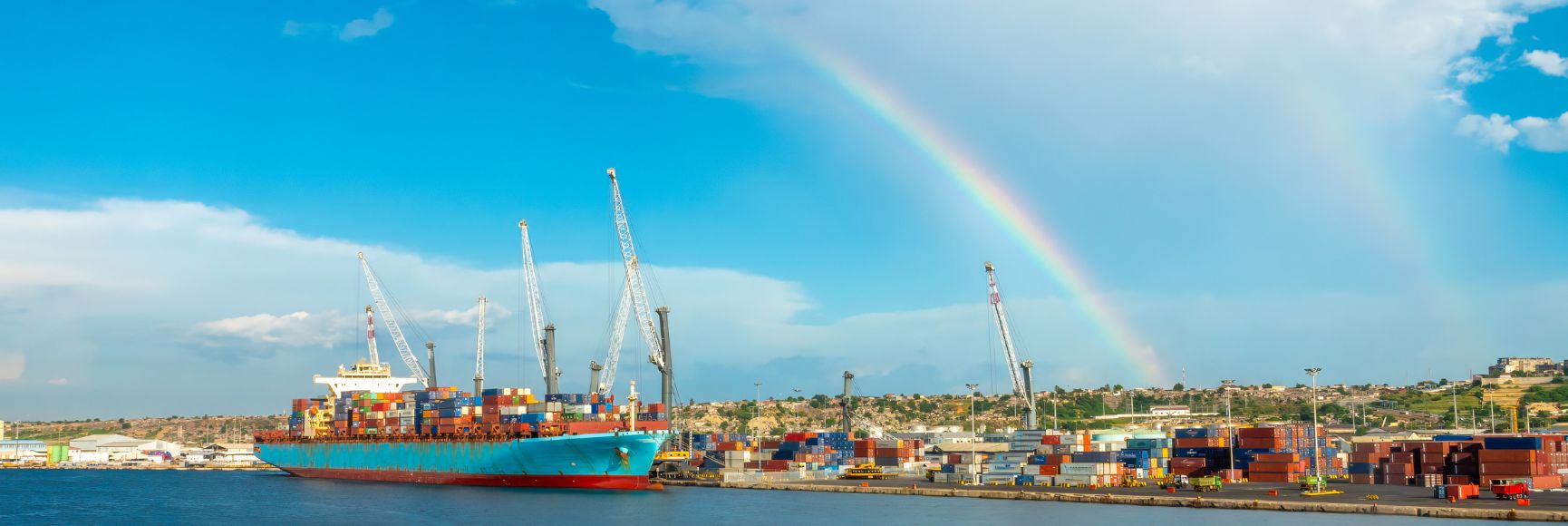Posted by Andrew Bauer and David Mihalyi[1]
Headlines about resource-rich economies faltering under crashing world commodity prices fill the news. "Venezuela in a bind as Nicolas Maduro faces default dilemma;" "Alberta premier considers sales tax to fix ailing, oil-based economy;" "Iran says it can no longer afford Ahmadinejad's cash handouts".
Since February 2013, the metals’ price index has dropped by over 30 percent, led by a 60 percent decline in iron ore prices and a nearly 22 percent decline in copper prices. Crude oil prices have dropped nearly 50 percent since June 2014. The resulting loss in fiscal revenues in resource-dependent countries has exposed severe vulnerabilities in some.
 Yet for every crisis, there is a government that was well-prepared (Table 1). Some spent years paying
Yet for every crisis, there is a government that was well-prepared (Table 1). Some spent years paying
down public debt so they could borrow when needed, saved money in a , or diversified their economies, making them less vulnerable to commodity price cycles or production stoppages.
Neither geography, level of economic development nor degree of democracy explains why one government is well-prepared for a price downturn while another is not.
Stability for some…
Most successes involved a consensus that fiscal stability and sustainability should drive public finance decisions. Peru, for instance, passed a 1999 law establishing a deficit limit and an expenditure growth rule, following decades of economic crises. This reduced public debt from 44 percent of GDP in 2004 to 20 percent in 2012, one of the lowest rates in Latin America. In Norway, political parties jointly committed in 1990 to set the non-oil budget deficit at 4 percent, the expected long-term return on savings in the sovereign wealth fund. This followed decades of financial mismanagement, including two banking crises.
Timor-Leste has also taken a long-term approach to managing natural resource wealth. A 2005 law limited the annual transfer to the budget to 3 percent of petroleum wealth, unless special justification was provided to parliament. Any excess hydrocarbon revenue is saved in in the Fund. Since then, the government has never run a fiscal deficit, and built up $15.7 billion in savings ($13,000 USD per capita) by July 2014. As oil prices collapsed, the 2015 budget only called for $70 million in borrowing (4.5 percent of the budget).
… and crises for others
Not all have done so well. Some resource-rich states have faced major financial and economic crises, and even violent conflict. These countries have little in common other than the absence of a long-term macroeconomic framework to handle their commodity booms. For example, Venezuela vastly increased government spending after the 2005 oil price rise. The government has run a fiscal deficit every year since then, even during boom periods. The IMF estimates that the 2015 budget deficit could approach 20 percent of GDP .
In response, Venezuela’s government has extended price and exchange rate controls, and nationalized companies that provide basic goods and services. This has caused import shortages, a growing foreign currency black market, hyperinflation, and street demonstrations.
In mineral-rich Mongolia, exuberance around mining prospects contributed to a public and private sector spending boom that accelerated in 2010. The copper price crash—and consequent fiscal revenue decline—underscores the high structural deficit. Mongolia has been left exceedingly vulnerable to further shocks, and is “at high risk of debt distress,” according to the IMF, while the government and state-owned companies are paying some of the world's highest interest rates on international sovereign debt markets.
In both these cases, the problems started before the 2012-14 commodity slump. As in some other countries (e.g. Mexico, Malaysia, Iran), their governments were in structural deficit before the crash. Public spending was not generating the growth necessary to meet public sector obligations over the long term without relying on oil, gas or mining revenues.
Unrealistic expectations
Unrealistic expectations around resource revenues have played a role in overspending and debt crises. In Ghana and Mongolia, for instance, claims of vast national wealth directly contributed to consumption-driven booms. Recently, Ghana was forced to sign an IMF adjustment and restructuring program. While it saved almost $500 million in oil revenues in sovereign wealth funds from 2012-14, the government borrowed approximately $7 billion on international financial markets, at interest rates approximately 5 percent higher than the rate of return on sovereign wealth fund assets. Lack of transparency in public finances can exacerbate overspending. In the Republic of Congo, opaque reporting practices led observers to falsely believe that the country was prepared for the current crisis.
Beyond the immediate fiscal crises, budget cuts (e.g. Iran cutting cash transfers), asset sales (e.g. Russia accessing the National Wealth Fund), and tax increases (e.g. Alberta's plans to raise corporate and income taxes), the commodity price crash impacts longer-term macro-fiscal plans. For instance, Papua New Guinea has delayed implementation of its sovereign wealth fund and Afghanistan and Liberia have shelved similar plans for now.
At the same time, some governments are learning lessons on managing natural resource wealth. In Mongolia, the government has introduced a bill calling for a portion of windfall revenues to be saved in a new fund. And the oil-rich Indonesian regency of Bojonegoro is planning a fiscal rule and fund to save a portion of subnational government shares of oil revenues.
Success factors
There are a few commonalities among resource-rich governments that have successfully countered fiscal revenue volatility and maintained fiscal responsibility despite extractive resource wealth.
First, each country has a history of sticking to a macroeconomic framework, often anchored by a fiscal rule that generates a surplus, saved in a sovereign wealth fund or used to pay down public debt.
According to IMF estimates, national governments comply with at least some fiscal rules approximately 60 percent of the time.[3] Balanced budget rules are broken most often since they are complex and difficult to enforce. Expenditure and debt rules are simpler, which helps explain the higher rates of compliance. Expenditure and revenue rules have the added benefit of being counter-cyclical, making them particularly appropriate for emerging resource-rich economies.
Second, most successful resource-rich countries have competent and powerful finance ministries and strong oversight of public finances.
Third, many of the leaders of these countries have committed to long-term fiscal sustainability, resisting the temptation to curry popular favour though status projects like stadiums.
Finally, political consensus plays an important role in compliance with fiscal rules or fiscal sustainability and stability principles, as in Norway and Timor-Leste.
While we don't have all the answers, recent experiences may help us better manage future commodity price booms—and busts.
This blog is adapted from an article on the NRGI webpage. The full article can be viewed here.
[1] Andrew Bauer is the Natural Resource Governance Institute’s (NRGI) Senior Economic Analyst; David Mihalyi is an NRGI Economic Analyst.
[2] We use the label “well prepared government” here to mean one that meets two conditions: (1) the government is in a sustainable fiscal position in absolute terms, meaning that it has low public debt levels and/or relatively large holdings of foreign assets to withstand a prolonged commodity price slump; and (2) the government acted in a fiscally responsible manner relative to its degree of capital scarcity in the decade(s) prior to the commodity crash, meaning that, if it was capital-rich a significant portion of resource revenues were saved, whereas if it was capital-scarce it was investing well in human and physical infrastructure.
[3] Cordes, Till et al. (2015) Expenditure Rules: Effective Policy Tools for Sound Fiscal Policy? IMF Working Paper 15/29.






